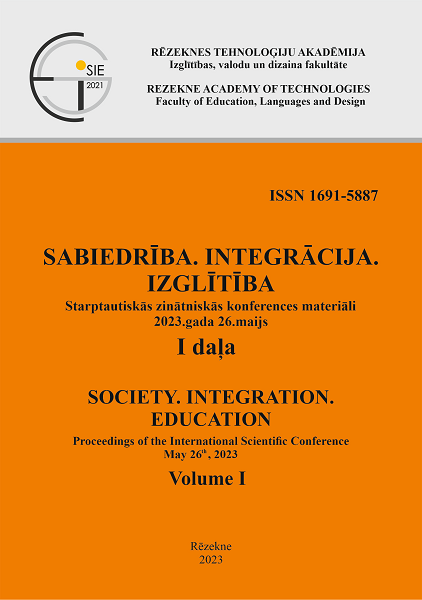FORMS OF THE DIFFERENTIATION OF WORK WITH TEXTS IN PRIMARY SCHOOLS
DOI:
https://doi.org/10.17770/sie2023vol1.7167Keywords:
differentiation of students’ learning, forms of learning differentiation, differentiated work with texts, tasks of different levels, teaching primary school students, ways of application of differentiated learning, works with textsAbstract
This article justifies the importance and relevance of the use of differentiated work with texts starting with primary school. Results of the analysis of scientific and methodological literature, modern teaching practice on the reflection of the issue of using various forms and kinds of differentiation are described. It is underlined that differentiation of learning is based on discovering and reckoning with the individual characteristics of students and their differences. Individualization of teaching is interpreted as the highest stage of differentiation. Described ways and kinds of differentiation are the most adequate for the effective differentiated work with texts. Such criteria as the level of a student’s autonomy in completing tasks and the complexity of an educational work are at the heart of this classification. Varying levels of autonomy in educational work are ensured by joint completion of tasks, independent work, playing the role of a consultant. The difficulty of tasks is provided by various ways of formulating tasks and the variation in their content. One more regulator of the tasks’ difficulty is the volume and the level of difficulty of texts. As a result of effectiveness checks of the use of aforementioned forms and ways of differentiation of primary school students with educational texts significant positive effect was found.
References
Bönsch, M. (2014). Heterogenität und Differenzierung. Gemeinsames und differenziertes Lernen in heterogenen Lerngruppen. Grundlagen der Schulpädagogik, Band 67. Baltmannsweiler: Schneider Hohengehren.
Busel, V. (2003). Velykyi tlumachnyi slovnyk ukrainskoi movy. Irpin: Perun.
de Groot, R. (1994). Differentsiatsiya v obuchenii. Direktor shkolyi, 5. Retrieved from: http://ecsocman.hse.ru/data/376/913/1231/Differentsiatsiya_v_obrazovanii_x28De_Gr oot_R.x29.rtf
Deinichenko, T. (2006). Dyferentsiatsiia navchannia v protsesi hrupovoi formy yoho orhanizatsii (na prykladi predmetiv pryrodnycho-matematychnoho tsyklu) (avtoref. dys. … kand. ped. nauk). Kharkivskyi natsionalnyi pedahohichnyi un-t im. H. S. Skovorody. Kharkiv, Ukraina.
Kabinet Ministriv Ukraini. (2018). Derzhavnyi standart pochatkovoi osvity. Retrieved from: http://nus.org.ua/news/uryad-opublikuvav-novyj-derzhstandart-pochatkovoyi-osvity-dokument/
Dychkivska, I. (2004). Innovatsiini tekhnolohii navchannia: navch. posib. Kyiv: Akademvydav.
Grzegorzewska, S. (2009). Różnicowanie kształcenia w klasach początkowych. Kraków: Impuls.
Grunder, H. U. (2009) Dynamiken von Integration und Ausschluss in der Schweiz. Zürich: Seismo.
Hofmann, F., & Gottein, H.-P. (2011). Zusammenhänge zwischen Persönlichkeitsmerkmalen und der Bereitschaft zur Individualisierung im Unterricht. Zeitschrift für Bildungsforschung, 1(1), 55-67.
Yaremenko, V., & Slipushko, O. (1998). Novyi tlumachnyi slovnyk ukrainskoi movy u chotyrokh tomakh / uporiad. T. 4. Kyiv: Akonit.
Klafki, W., & Stöcker H. Innere Differenzierung des Unterrichts. Zeitschrift für Pädagogik, 22(4), 497-523.
Kolomiiets, M., & Moldova, L. (1998). Slovnyk inshomovnykh sliv. Kyiv: Osvita.
Kuhne, F. (2013) Differenzierung und Individualisierung im Fremdsprachenunterricht. Optimierung einer Lehrbucheinheit aus Puente 1. Retrieved from: https://www.grin.com/document/267817
Kyzenko, V., Vaskivska, H., Korsakova, O., Lypova, L., Trubacheva, S., Baranovska, O., Bondar, S., & Osadchuk, R. (2012). Dydaktychni zasady dyferentsiatsii navchannia v osnovnii shkoli: monohrafiia. Kyiv: Pedahohichna dumka.
Kuzmina, O. V. (2001). Dyferentsiiovane navchannia v umovakh hrupovoi formy navchalnoi diialnosti uchniv pochatkovoi shkoly (avtoref dys. … kand. ped. nauk). Slovianskyi derzh. pedahohichnyi in-t. Sloviansk, Ukraina.
Lohachevska, S. (1998). Dyferentsiatsiia u zvychainomu klasi. Kyiv: Zapovit.
Oleksin, Yu. (2013). Suchasni naukovi pidkhody do vyznachennia sutnosti dyferentsiatsii navchannia shkoliariv. Psykholoho-pedahohichni problemy silskoi shkoly, 46, 130-138.
Savchenko, O. (2012) Dydaktyka pochatkovoi osvity. Kyiv: Hramota.
Sikorskyi, P. (1998). Teoretyko-metodolohichni osnovy dyferentsiiovanoho navchannia. Lviv: Kameniar.
Shevchuk, L. (2019). Chytaiemo. Rozumiiemo. Tvorymo: navchalna prohrama kursu za vyborom. 2-4 (1-4 klasy). Retrieved from: https://undip.org.ua/library/chytaiemo-rozumiiemo-tvorymo-2-4-klasy-1-4-klasy-navchalna-prohrama/
Tereshchuk, A. (2015). Sutnist ta osnovni zavdannia profilnoho navchannia u konteksti modernizatsii ukrainskoi osvity. Naukovyi visnyk Kremenetskoi oblasnoi humanitarno-pedahohichnoi akademii im. Tarasa Shevchenka. Seriia: Pedahohika, 5, 116-122.
Vaskivska, H. (2018). Geneza dyferentsiiovanoho navchannia: dydaktychnyi aspekt. Dyferentsiatsiia u shkilnii osviti: istorychnyi dosvid i suchasni tekhnolohii: zbirnyk materialiv Vseukrainskoi naukovo-praktychnoi konferentsii, 16 travnia 2018 roku, m. Kyiv. Kyiv: Instytut pedahohiky, 16–20.
Wegner, A. (2018). Individualisierung und Differenzierung im Unterricht. Welche Meinungen, Haltungen und subjektiven Wahrnehmungen vertreten Deutschlehrkräfte zur Umsetzung der individuellen Förderung besonders im Bereich Schreiben? Retrieved from: https://www.grin.com/document/461774
Zhovtan, L. (2001). Dyferentsiatsiia navchannia uchniv 7-11 klasiv u protsesi pohlyblenoho vyvchennia predmetiv pryrodnycho-matematychnoho tsyklu (avtoref. dys. … kand. ped. nauk). Kharkiv, Ukraina.






